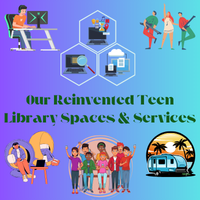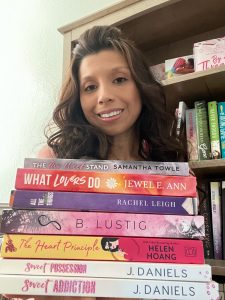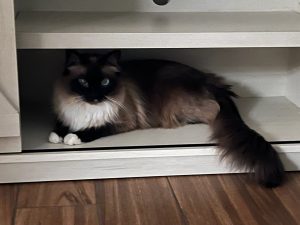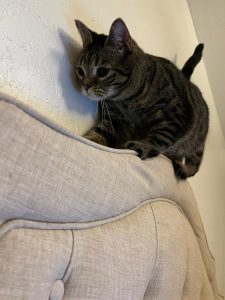According to Professor Stephens’ (2022) lecture, he communicates that “hyperlinks are people that can occur in conversations, in learning experiences, in sharing, and in performative pieces in any number of things that might play out in our hyperlinked library model” (0:47-1:01). Libraries are at the heart of one’s community, where their ultimate goal is to connect and educate individuals to equal and equitable library resources and services. And libraries’ roles as book repository and computer lab centers have evolved and gone beyond new forms of engagement where they offer a wide variety of full services that benefit their patrons’ social needs as well as their physical and mental well-being. An exemplary model of this service would be the Community Closet, which is in the basement of the Capital Areas District Libraries (CADL) in Downtown Lansing Library. I found the Community Closet to be fascinating because of the idea of it being open to all members of the community and they can obtain whatever hygiene or personal items they need without being questioned, judged, or obligating to apply for a library card. This led me to explore other CADL featured projects and their partnerships with other organizations such as Fill the Shelves, Food Packs, Micro Food Pantries, and Casual with a Cause. It amazes me to learn that libraries have taken the initiative to “reduce or remove barriers to become better supportive agencies” (Forrest, 2022, p. 64), especially to help those most vulnerable or underserved populations to feel more inclusive.
The Toronto public libraries take it up a notch by partnering with the Personal Care Bank organization to install cabinets around the outside of the facilities’ buildings, which are stocked with basic personal care products that anyone can take as well as donate what they are able to. This project is unique because it eases the minds of community members who have had to make sacrifices and do without these basic essentials, which they now have full access to 24/7. They can secure unused and donated items that would “improve their confidence to manage their own health and well-being” (Greenwood, p.24).
In Wisconsin there are public libraries who are lending a helping hand by presenting extra benefits for people in need such as addressing the homeless crisis and how to improve their state of sustainability. An example is of the Brown County Public Library where they have a program called Community Resource Tuesday, which allows for patrons to meet at an appointed time with social services providers about mental health issues, housing or sheltering information, food insecurities, etc. Their Central Library also contains a hydroponic farm and garden that grows produce and is later made available to all those in need. I also discovered the Fond du Lac Public Library implemented safe spaces and programming in times of harsh and cold weather months, such as the Book Chat program. This program is held on Tuesday mornings near their built-in fireplace. All patrons are welcome to sit by the library’s fireplace to bask in the warmth and indulge in a book, work on their devices, or have a pleasant conversation with another person. Most unhoused patrons usually occupy this space because they find solace in the quiet as well as immerse in their own thoughts or express their interests with others. These kinds of good deeds and contributions epitomize @michael notion of how they are “steeped in humanism, compassion, and understanding should be the cornerstone of what we do, and why we do it, for all members of our communities, including the underserved” (Garcia-Febo, 2018).
References
Brown County Library. (n.d.). Brown County Library. https://www.browncountylibrary.org/
Burman, D. (2023, August 10). Free hygiene products available at some Toronto library branches through the Personal Care Bank. CityNews Toronto. https://toronto.citynews.ca/2023/08/10/free-hygiene-products-toronto-library-branches-the-personal-care-bank/
CityNews. (2023, August 10). Toronto public library teams up with the Personal Care Bank [Video]. YouTube. https://youtu.be/K-XLoPKTrJM?si=0lYdGz_FoVV7Frlj
Fond du Lac Public Library. (n.d.). Fond du Lac Public Library. https://www.fdlpl.org/
Fetalvero, S. (2024). Hyperlinked communities. Canva. https://www.canva.com/design/DAGJk70IeHc/L2Lx2qPxChxPZUDvq5uP8Q/view?utm_content=DAGJk70IeHc&utm_campaign=designshare&utm_medium=link&utm_source=editor
Forrest, M. (2022). Public libraries and the Social Inclusion of homeless people: A literature review. Pathfinder: A Canadian Journal for Information Science Students and Early Career Professionals, (3)1, 64-80.
Garcia-Febo, L. (2018, November 1). Serving with love: Embedding equality, diversity, and inclusion in all that we do. American Libraries. https://americanlibrariesmagazine.org/2018/11/01/serving-with-love/
Greenwood, C. (2022). Healthy library, healthy life. Incite, 43(6), 24.
Stephens, M. (2022). Hyperlinked library master lectures 2022: Hyperlinked communities [Video]. Panopto. https://sjsu-ischool.hosted.panopto.com/Panopto/Pages/Viewer.aspx?id=3eacdb23-84fd-49e5-9975-aef3014b3ed2
Wisconsin Department of Public Instruction. (2023, December 19). How Wisconsin libraries are helping meet the needs of people experiencing homelessness. Wisconsin Department of Public Instruction. https://dpi.wi.gov/news/dpi-connected/how-wisconsin-libraries-are-helping-meet-needs-people-experiencing-homelessness





